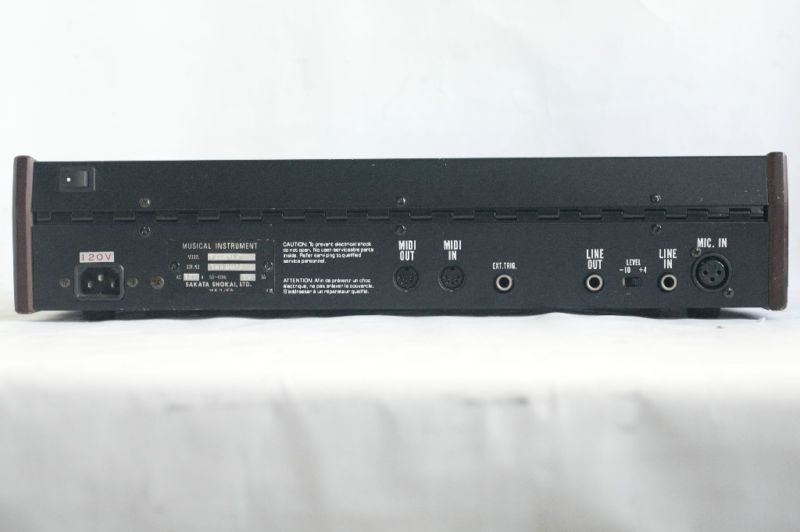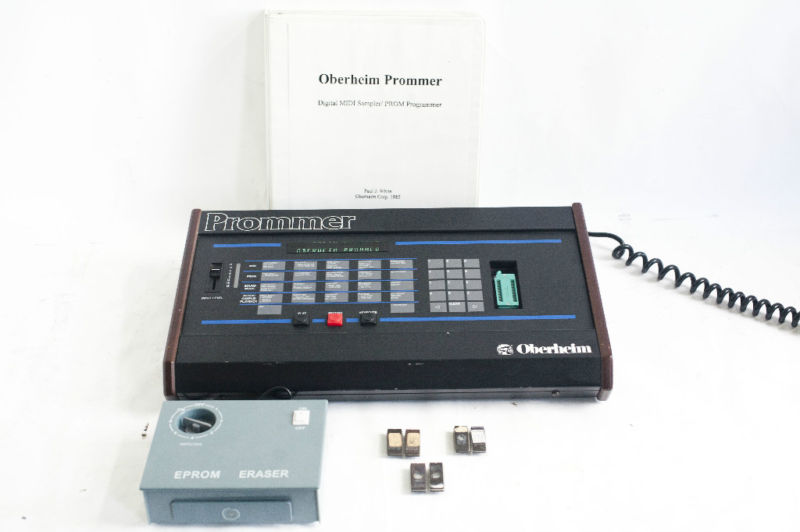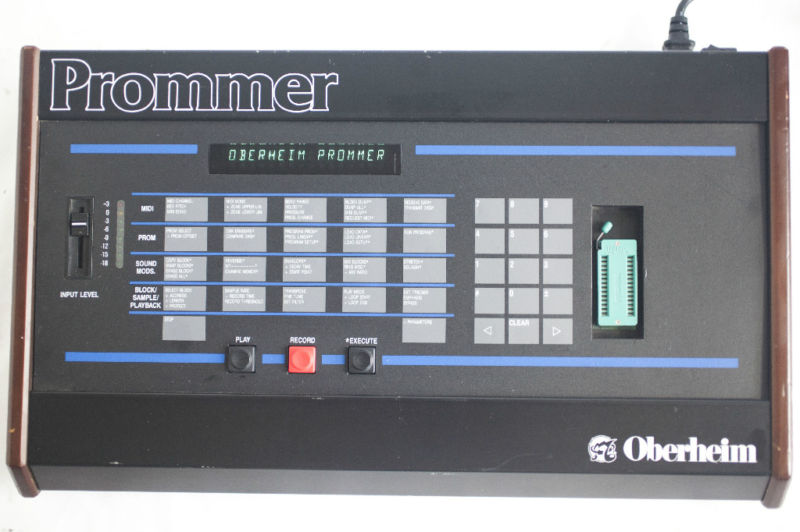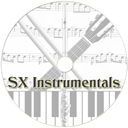Filter on ALL, SYNTH, DRUM, SAMPLER or MISC |
Total list currently 2405 items in 330 Brands |
Oberheim | Prommer |
Description | The Oberheim Prommer is a powerful and versatile tool for the modern musician. Although the Prommer was designed to be very versatile and easy to use, it is still a complex instrument and will require some learning on the user's part in order to use it properly. Please read this manual carefully and keep it with the Prommer for future reference. WHAT DOES IT DO ? SAMPLES SOUNDS The Prommer is a digital audio sampling device, that will convert an audio signal into digital form and store the digitized signal in its memory. The Prommer will record at a rate of up to 32,000 samples per second and has a maximum memory capacity of 65,536 samples. This means that you can record a sound that is about two seconds long at the fastest sampling rate. Longer sounds may be sampled by using a slower sampling rate at a reduced audio bandwidth. One primary application of the Prommer is sampling drum sounds and other percussive sound effects. There is an input for line level signals (with switchable sensitivity of +4 dB or -10 dB), and a balanced input for a low impedance microphone. A peak reading LED meter allows monitoring the level of the input signal in order to set the correct recording level. BURNS PROMS The Prommer is also a PROM programmer. It can program ("burn") most popular types of EPROMS, PROMS and EEPROMS. This means that you can make your own custom sound chips to use in your Oberheim DMX or DX digital drum machine. The Prommer will also program chips for other brands of drum machines, that is any drum machine that uses individual sound chips with eight bit companded or linear data format. PLAYS BACK SOUNDS The Prommer can play back sounds in memory over a twelve octave pitch range when used with a MIDI controller, with control over transposition and fine tuning. Sounds may be looped to add sustain, with adjustable loop points. An external trigger may be used to play a sound, and a low pass filter at the output will track the playback rate or can be set to a selected frequency. UNDERSTANDS MIDI MIDI note-on commands can be used to play sounds at different pitches with velocity and pressure controlling loudness and/or filter frequency. MIDI pitch wheel information can also control pitch to allow 'bending' notes. The Prommer can transmit sound data over MIDI to another Prommer or to another machine that uses a proposed standard MIDI sample dump. The Prommer can also record received MIDI data directly into memory and retransmit it on command. This feature is useful for saving synthesizer patches, drum machine sequences, etc. STORES MULTIPLE SOUNDS The memory of the Prommer may be divided into 16 blocks . Each block may be defined to cover any portion of memory and may even overlap other blocks. All operations (Record, Play, Program PROM, etc.) take place only within the currently selected block . When you record a sound, for example, sound is recorded only into that part of memory defined by the current block. This means that you can have as many as 16 different sounds in memory at one time. Non-volatile (battery powered) memory is used so all your sounds will be retained in memory even with the power off. MANIPULATES SOUND DATA Sounds may be modified in several ways including reversing, mixing, stretching, squashing, and enveloping. These Sound Mod functions don't take place in real time but actually change the data in memory so that the change is permanent and the modified sound can be burned onto a PROM. Data in memory may also be examined and modified numerically one byte at a time. AND MORE ! The Prommer has an almost endless variety of possible applications including (but not limited to) - sampling sounds for drum machines, copying EPROMs, transferring multiple EPROM sounds to a single EPROM, drum machine sound editing, transferring sounds from linear format drum machines to companded format machines and vice-versa, playing sounds with a keyboard, and MIDI data storage. |
| Brand | Oberheim |
| Model | Prommer |
| Device | Misc |
| Type | Desktop |
| Engine Type | Memory |
| Engine | * |
| Voices (max) | 1 |
| Sampler | 8-bit, Variable sample rates |
| Envelope (VCA) | Start Point, Decay Time |
| FX | Reverse, ring-mod, digital bit manipulation |
| Memory | EPROM Chips |
| Keys | 0 |
| Key type | N/A |
| Velocity | N/A |
| Aftertouch | N/A |
| Midi | I-O-T |
| Produced: | 1984 - 1984 |
| Legend: | Obvious | Y: Yes, N: No, N/A: Not Applicable | |
| VCO | Voltage Controlled Oscillator | DCO | Digital Controlled Oscillator |
| LFO | Low Frequency Oscillator | Sub | Sub Oscillator |
| VCF | Voltage Controlled Filter | VCA | Voltage Controlled Amplifier |
| Velocity | As with a piano, the harder you hit a key, the louder the sound, unlike most organs which always produce the same loudness no matter how hard you hit a key. | Aftertouch | Pressing a key after you activated it. Channel Aftertouch, no matter which key, it will send a Channel message. Poly Aftertouch, sends the pressure per key instead of the whole channel. |
| Values for OSC, LFO, Filter, Envelope are per voice unless stated otherwise. | |||





